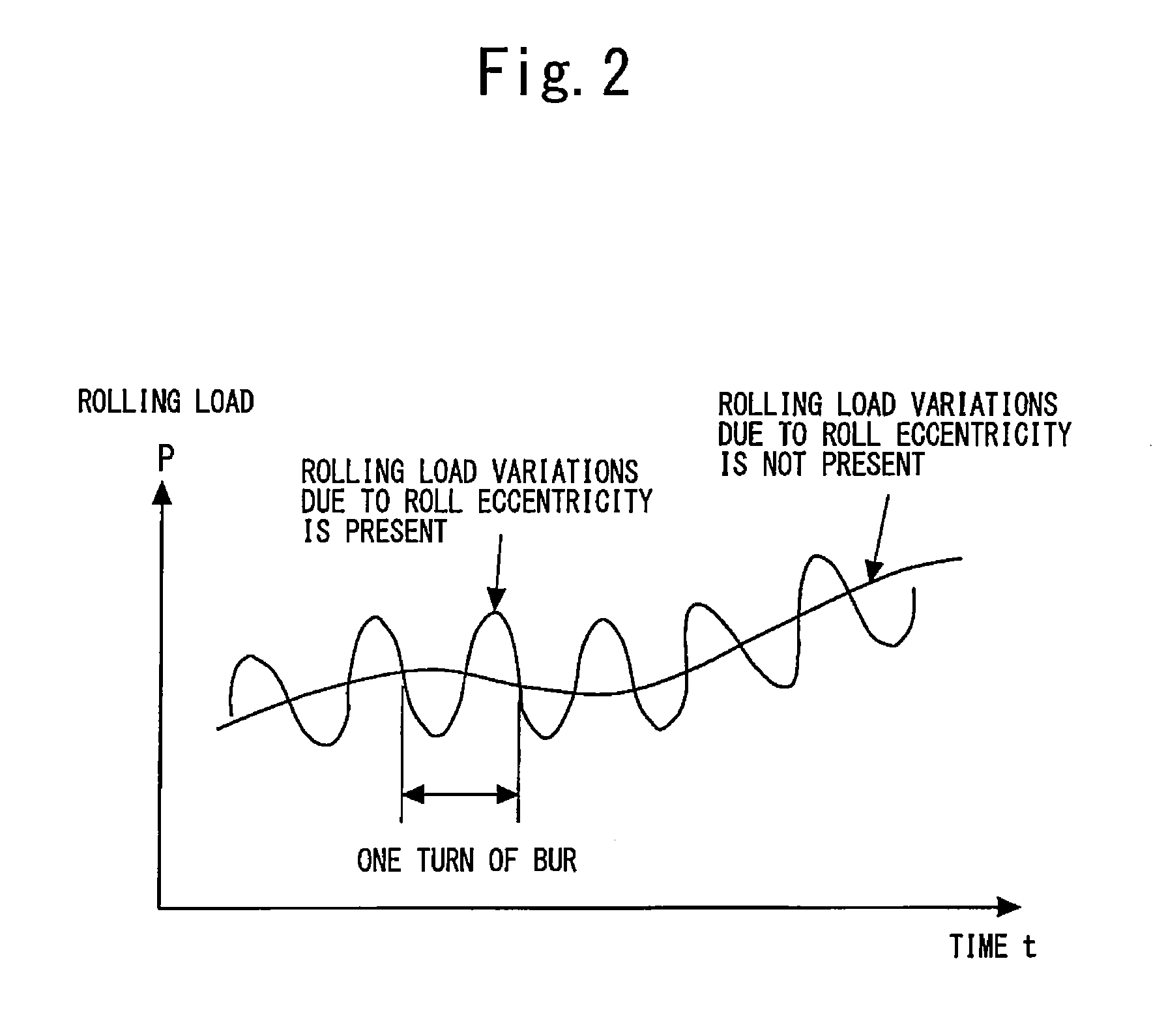Control apparatus of rolling mill
a control apparatus and rolling mill technology, applied in the direction of rolling mill control devices, metal rolling arrangements, manufacturing tools, etc., can solve the problems of periodic roll gap variations dependent on the rotation of the roll, shaft movement up and down (undergo shaft oscillation), and the thickness accuracy of the harrowing improvement, etc., to achieve the effect of suppressing periodic disturbances
- Summary
- Abstract
- Description
- Claims
- Application Information
AI Technical Summary
Benefits of technology
Problems solved by technology
Method used
Image
Examples
first embodiment
[0039]FIG. 1 is a diagram showing the general configuration of a control apparatus of a rolling mill in a first embodiment according to the present invention.
[0040]In FIG. 1, reference numeral 1 denotes a rolled material, which is made of a metal material, reference numeral 2 denotes a housing of a rolling mill, reference numeral 3 denotes a work roll, and reference numeral 4 denotes a back up roll. The rolled material 1 is rolled by the work rolls 3 whose roll gaps and speeds are appropriately adjusted so that a desired thickness is obtained on the exit side of the rolling mill.
[0041]In FIG. 1, a 4Hi mill is shown as an example of a rolling mill. That is, in this embodiment, the work roll 3 includes a top work roll 3a and a bottom work roll 3b. The back up roll 4 includes a top back up roll 4a and a bottom back up roll 4b. The work roll 3 is configured in such a manner as to be supported by the back up roll 4 so that deflection in the roll width direction becomes small. Specificall...
second embodiment
[0118]FIG. 9 is a diagram showing the general configuration of a control apparatus of a rolling mill in a second embodiment according to the present invention.
[0119]In FIG. 9, reference numeral 27 denotes roll gap top / bottom variation identification means, reference numeral 28 denotes top / bottom identified roll gap variation storage means, and reference numeral 29 denotes manipulated variable computation means.
[0120]In the first embodiment, the description was given of the case where load signals are accumulated in the adders 26a and 26b of the load top / bottom variation identification means 11. However, the rolling load sometimes shows changes in the amplitude of variations depending on the width, deformation resistance (hardness) and the like of the rolled material 1. Therefore, in this embodiment, a description will be given of the case where a load signal is converted to a value corresponding to a roll gap and then, accumulated to the adder. With this configuration, it becomes po...
third embodiment
[0135]FIG. 12 is a diagram showing the rolling mill shown in FIG. 1 as viewed from the rolling direction of a rolled material.
[0136]There are cases where roll gap variation components caused by the roll eccentricity and the like are not the same on the right and left sides of the rolled material 1, i.e., on the drive side and the operator side of the rolled material 1, for example, in the case where the construction of oil bearings used in the back up roll 4 is laterally asymmetrical. This control apparatus is provided with the screw-down device 5, the load detecting device 6, and the roll gap detector 9 on both the drive side and the operator side, and the mechanism of this control apparatus are such that a roll gap can be separately controlled on the drive side and the operator side. For this reason, in this embodiment, a description will be given of the case where on the drive side and the operator side, variation components due to periodic disturbances are separately identified ...
PUM
| Property | Measurement | Unit |
|---|---|---|
| rotational angle | aaaaa | aaaaa |
| thickness | aaaaa | aaaaa |
| displacement | aaaaa | aaaaa |
Abstract
Description
Claims
Application Information
 Login to View More
Login to View More - R&D
- Intellectual Property
- Life Sciences
- Materials
- Tech Scout
- Unparalleled Data Quality
- Higher Quality Content
- 60% Fewer Hallucinations
Browse by: Latest US Patents, China's latest patents, Technical Efficacy Thesaurus, Application Domain, Technology Topic, Popular Technical Reports.
© 2025 PatSnap. All rights reserved.Legal|Privacy policy|Modern Slavery Act Transparency Statement|Sitemap|About US| Contact US: help@patsnap.com



